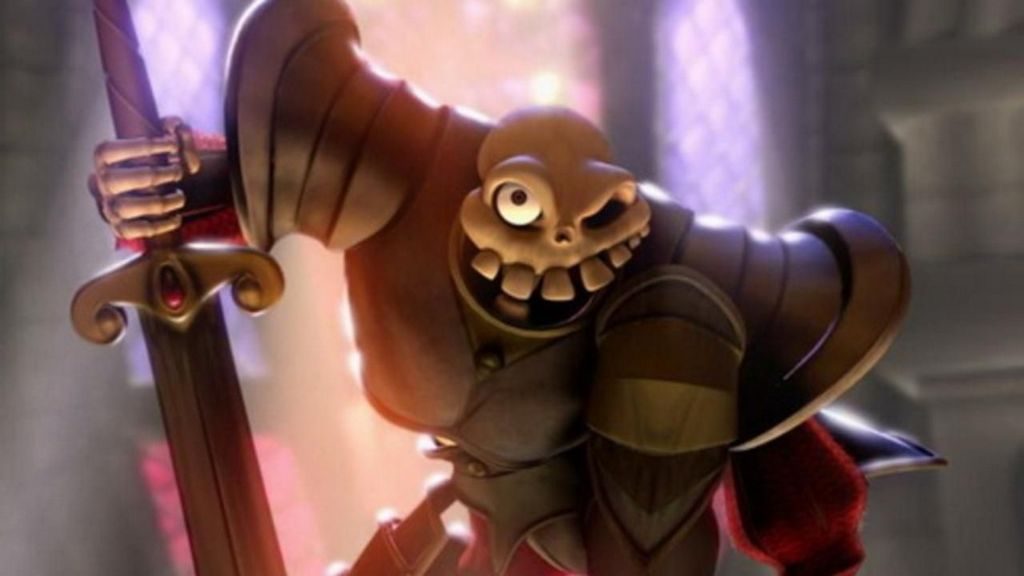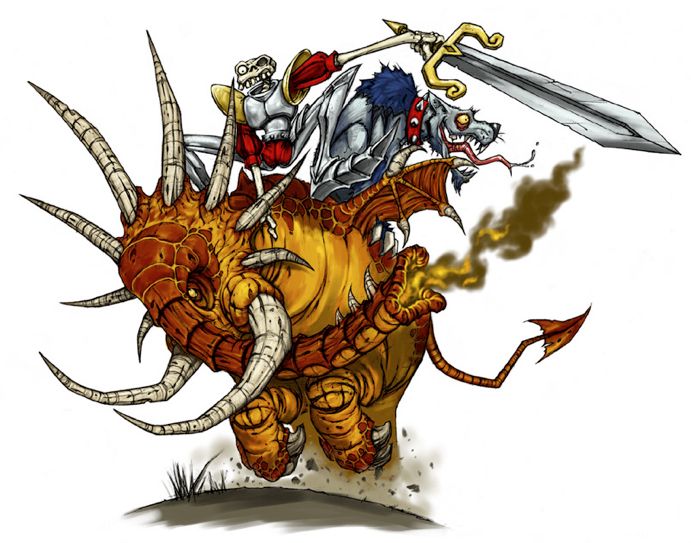MediEvil was a hack and slash adventure series that consisted of two games on the original Playstation (MediEvil in 1998 and MediEvil 2 in 2000) and a third game on the PSP (MediEvil: Resurrection in 2005). All three games were developed by SCE Cambridge Studio (now Guerrilla Cambridge), and although the series was moderately successful it was never granted the greenlight for a true third installment (MediEvil: Resurrection just being a remake / re-imagining of the first game). However, a concept for a MediEvil sequel on the Playstation 2 was actually pitched back in early 2003, when the developers within Sony Cambridge were considering several options after the less than amazing sales of Primal.
This new game would have been called “MediEvil 3: Fate’s Arrow”, a title that was later reused as an inside Easter egg for the name of a mini-game (Arrow o’ Fate) in MediEvil: Resurrection. Loosely, the story would continue from where MediEvil 2 left off, with Sir Dan travelling back in time to Gallowmere. Specifically, he travels back 100 years before the events of MediEvil 1, and just a few weeks before the Battle of Gallowmere is due to occur. We know that by rights, Sir Daniel Fortesque will be shot in the eye by the first arrow thus freeing up his men to fight on to victory, unburdened by his ‘leadership’. But Dan learns that the timeline has somehow changed: a mysterious new figure has aligned herself with Zarok – an Egyptian sorceress: Kiyante.
Kiya has played Dan like a fiddle: tricking him into rescuing her, stealing the Time Machine and delivering her into the company of the one figure from history whose evil ambitions (and talents) mirror her own. By using the fabled Anubis Stone she will aid Zarok by raising an army of undead. She will ensure that living Sir Dan doesn’t die so soon and instead sticks around long enough to truly doom his brave compatriots. If that happens, together Zarok and Kiyante would achieve a crushing victory, the earth would be overrun with demons and mankind enslaved.
The aim of the game was for Sir Dan to keep the timeline pure by stealing the Anubis Stone and ensuring that his cowardly living self is firstly compelled into leading the battle charge and falls at the first arrow, allowing Zarok to be defeated and history to play out as it should. This was also to be a chance to reflect on the real story of Sir Dan and in doing so to appreciate the true hero he has become in death compared to the miserable individual he was in life (there would have been a few shades of the British comedy series Black Adder here, season one specifically).
MediEvil 3 would have borrowed a few ideas from Primal, featuring a companion sidekick character who would be a key figure to the game. In this case, the companion is Lupo – Sir Dan’s originally-under-appreciated, but utterly faithful hound who first meets skeleton Sir Dan at the beginning of the game and then joins him in his journey. A squeaky dog toy was going to be an item you could throw around to direct his attacks, especially against larger enemies and bosses. Generally he would tear around as an AI character, loosely following you and doing general side-kickey stuff.
The game also would have featured a more open, hub based structure to the world with story driving things forward. Dan and Lupo would travel to both old and new locations of Gallowmere in their attempt to find allies to aid them against Zarok and Kiya and one ally they meet is an eccentric genie named Al-Zalam. The developers were also planning to bring back the Hall of Heroes after it was lost in MediEvil 2.
This third chapter of Medievil for Playstation 2 of course would have also featured some exciting new weapons, puzzles, and power ups. One new addition would be beast riding, where Dan gets a mount in the form of one of those weird elephant-dragon things that were seen in the underwater portion of The Lake from MediEvil 1. Below you can see one of the concept arts created for the MediEvil 3 pitch, with Sir Dan and Lupo riding the beast mount:
The depth of this game would have expanded the MediEvil universe in a whole new way and would have featured a satisfying conclusion to Sir Dan’s heroic journey. Sadly, this never came to be. At the time this game was pitched, a couple things happened: the popular 24 TV-series license became available to Sony Cambridge, and the PSP became a significant company focus. MediEvil: Resurrection on the PSP was ultimately conceived as a way to re-introduce the franchise with a shorter scale project. A couple elements from this MediEvil 3 concept were carried over into Resurrection – one of them being the Anubis Stone and another being the character Al-Zalam.
This lost MediEvil 3 project for PS2 was never more than a design proposal plus a few lovely artworks made to shown some of the new features and characters, but it would have been a great conclusion to the MediEvil trilogy. In January 2013 Sony restructured their Cambridge Studio to develop Killzone Mercenary for the PlayStation Vita and the team was renamed into Guerrilla Cambridge. Sony did not forgot MediEvil and they tried again to develop a third MediEvil in the following years with different developers, one game for Playstation 3 and another for Playstation 4: this time they even created a playable prototype, but in the end both projects were also cancelled. We’ll have more on the lost PS3 and PS4 MediEvil sequels in the future.
Article translated in Russian thanks to Sergey Tyutin!



